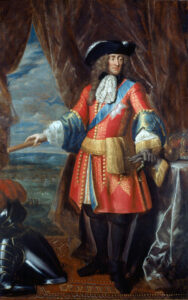James VII.
James II. of England
*10/1633
†09/1701
Parents
Father: Charles I.
Mother: Henriette Marie de Bourbon
Marriage
1st Anne Hyde
2nd Maria Beatrix d`Este of Modena
Children
6 Son´s → 4 with Anne, 2 with Mary
9 Daughter´s → 4 with Anne, 5 with Mary
Coronation
04/1685 in Westminster Abbey
Regency
02/1685 to 1688
By the Death of the first-born of Charles I. James was the second in the Line of Succession to Charles II. and was awarded the Title Duke of York in 1644. At the time of the english Civil War, James was in Oxford. After the capitulation of the City in 1646, he was put under Arrest by the Parliament in the St. James Palace, from where he was able to flee to Den Haag with the Support of Anne Halkett. From there, James traveled to France to serve in the french Army. When his brother Charles II. entered into an Alliance with Spain, he left France and joined the spanish Army.
In November 1659, he secretly married Anne Hyde, Daughter of the Earl of Clarendon, and traveled with her the following year to London, to his Brother’s side, where he officially repeated the Marriage in September 1660. Later, his Brother appointed him Lord High Admiral of the Royal Navy and renamed the North American City of New Amsterdam for James` Title in New York and the lying on the Hudson River Fort Oranje for his second Title (Duke of Albany) in Albany.
In 1668/69 James converted to Catholicism and had to resign as Admiral at the Request of Parliament. Although Charles disapproved of his Brother’s confession -he required James to raise his Children protestant- he allowed James to marry the catholic Princess Maria of Modena in 1673 after the Death of his Wife in 1673, even though many Englishmen distrusted her -they thought she was a spy for the pope . Although he tried to appease the Protestants by allowing his Daughter Mary to marry the protestant Governor William III. of Netherlands. However, he had to leave England due to the initiated by Titus Oates Catholic Hustle and flee to Brussels.
In 1680 he was appointed Lord High Commissioner of Scotland and went to Edinburgh. After the dissolution of Parliament in 1681, James finally returned to England.
In 1683 an Attack on James and his Brother Charles II. failed, as a result of which their popularity increased.
When Charles II. died without a legitimate Successor in 1685, James was crowned King as his successor in April, although James Scott -the illegitimate Son of Charles- was favored. The reunited Parliament, too, seemed well-disposed. However, Scott saw himself as the rightful heir to the Throne, appointed himself King in June 1685 and rebelled against the King. James was able to crush the Rebellion in the ‘Battle of Sedgemoor’, had Scott executed in the Tower of London and brutally persecute the rest of the party. In order to protect himself from further Uprisings James strengthened the Army. As he occupied the leading Posts with Catholics, he drew the displeasure of Parliament. The religious Tensions grew and James dismissed the Parliament, which should then no longer meet.
In 1687, James issued a Declaration of Indulgence, overriding all Laws designed to prosecute and punish People of other religious Beliefs, whether Protestant or Catholic. In April 1688, he resubmitted the Statement and ordered the anglican Clerics to read it from the Pulpits of their Churches, whereupon the Archbishop of Canterbury and several Bishops petitioned him to reconsider his religious policy. James let immediately arrested them and tried to put them for a Court, but they was released.
Enough is enough when Mary gave birth to a Son in June and the Public feared a catholic Succession. The leaders of the protestant Circles entered with James` Son-in-law, the Governor William III. of Oranien, in negotiations and asked him to ferry with a Fleet to give the Thrones of Scotland, England and Ireland in protestant Hands. Although William’s invasion loomed already in September 1688, James refused the Help of Louis XIV., fearing that the British would refuse a french Intervention. When in November 1688 William landed with an Invasion Force in southern England, James let his protestant Army Leaders down and changed the fronts. For James his Kingdom was lost and abdicate by throwing his Signet Ring into the Thames.
James was captured in December while fleeing to Kent. William, however, did not want to make him a Martyr and let him escape again. James went into Exile in France, where he was received by Louis, got a palace and alimony.
In March 1689, James -assisted by the french Army- landed in Ireland, whose Parliament did not follow the english and saw James still as their King. However, he was defeated in the Battle at the River Boyne and fled to Kinsale.
His “Cowardice” cost him the Support and was hunted off the Island. In 1296 there was tried to help James back to the Throne by assassinate William, but failed in planning and execution. After James refused the Offer to be elected King of Poland, he got no further Help from Louis XIV. James spent his last years as a penitent.
He died of a Stroke in September 1701.
Charles II. | James VII. | Mary II. & William III. | Anne
